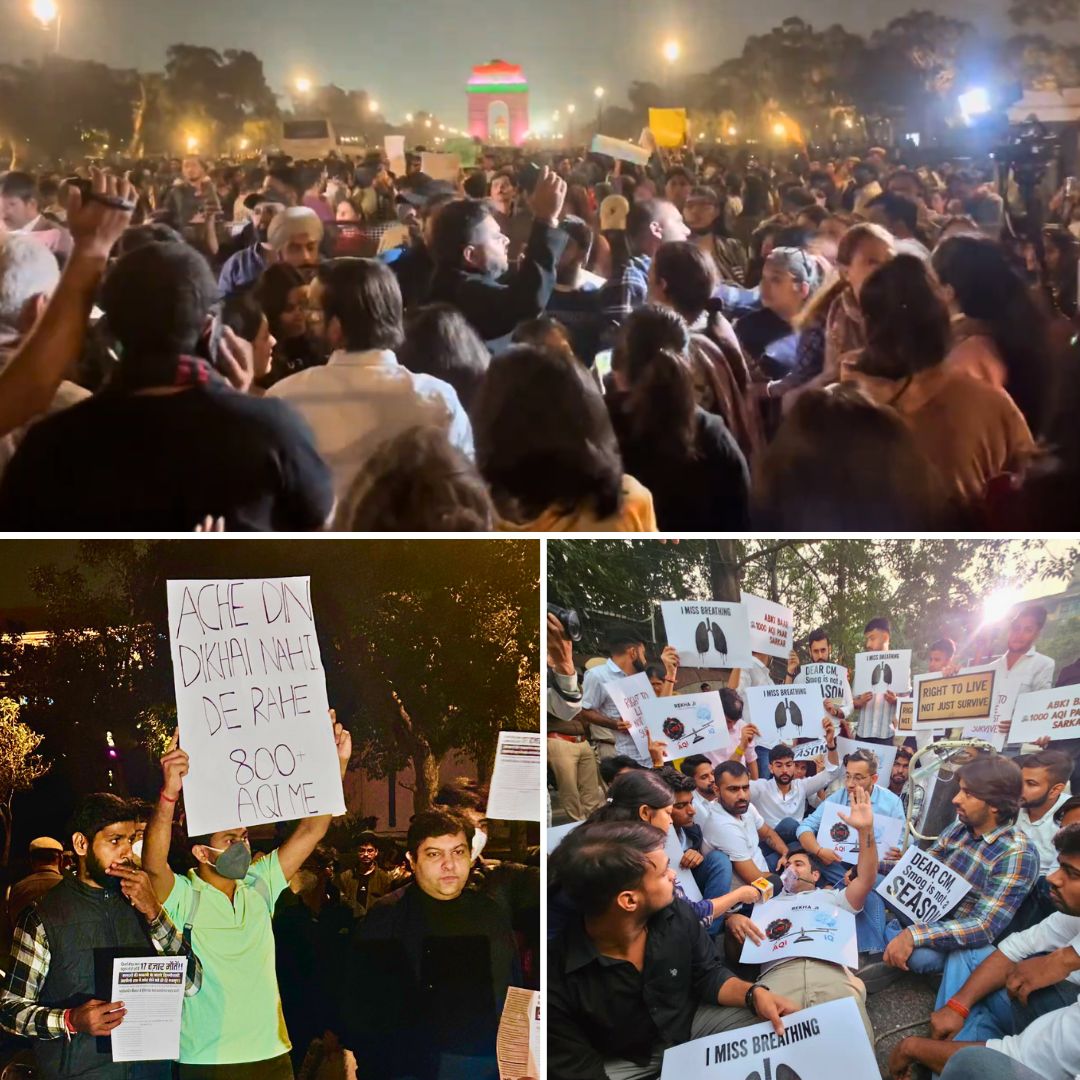On Sunday evening, a large protest against Delhi’s deteriorating air quality at India Gate escalated into chaos when protesters attacked police personnel with pepper spray.
Three to four officers were injured and are undergoing treatment at Ram Manohar Lohia Hospital. Police attempted to clear protesters citing a Supreme Court order mandating protests be held at Jantar Mantar, but protesters refused to disperse.
Authorities detained several individuals and launched an investigation, including into banners related to slain Naxal leader Madvi Hidma found among some demonstrators.
The protest reflects growing public frustration over Delhi’s persistent ‘very poor’ air quality and perceived government inaction.
Protest Erupts Amid Severe Air Quality Crisis
Sunday’s demonstration gathered hundreds of activists, students, and concerned citizens demanding urgent government action to tackle Delhi’s toxic pollution levels.
Participants carried placards asserting “Right to Clean Air” and called for stricter regulations on vehicular emissions, industrial pollutants, and agricultural stubble burning that contribute heavily to winter smog.
The protest began peacefully near the India Gate monument but escalated tension when protesters attempted to breach barricades in the C-Hexagon area, blocking ambulances and medical personnel.
According to a senior Delhi Police officer, “protesters became agitated and used pepper spray against officers during efforts to restore order.” Several injured officers were treated for exposure at RML Hospital.
Police deployed the Rapid Action Force to manage the situation and eventually moved detainees to police vehicles to clear the area.
Delhi’s Air Quality Crisis Worsens Annually
Delhi has long struggled with hazardous pollution, particularly in winter months when weather conditions trap pollutants close to the ground. On Sunday, the Central Pollution Control Board recorded an Air Quality Index (AQI) of 391 for the city, categorised as ‘very poor,’ with numerous areas exceeding ‘severe’ levels above 400.
The government’s Graded Response Action Plan (GRAP) activates traffic restrictions, construction halts, and pollution source controls during such periods, yet activists accuse authorities of insufficient enforcement and reliance on temporary measures like water sprinkling and cloud seeding attempts, which have thus far failed to produce lasting relief.
Earlier this month, similar protests occurred at India Gate and other city locations, underscoring the deepening frustration among residents over health risks posed by toxic air exposure, especially to children and vulnerable populations.
Background
Delhi has been witnessing escalating public unrest due to its alarming air pollution levels, especially in the winter months when smog worsens health risks. Recent protests at India Gate highlight growing frustration, with hundreds of activists, students, and residents voicing their demands for urgent government action to curb toxic emissions from vehicles, industries, and crop burning.
The capital’s Air Quality Index has consistently remained in the ‘very poor’ to ‘severe’ range, crossing 390 AQI on protest days, underscoring the failure of existing pollution control measures like the Graded Response Action Plan (GRAP). Citizens feel their health is in jeopardy, with many calling air pollution a “national health emergency.”
The government’s inability to implement long-term effective policies has provoked repeated protests, some turning confrontational as demonstrators resist restrictions on protest sites and enforcement efforts.
These protests reflect not only an environmental crisis but a deep public demand for accountability and sustainable action to reclaim the right to clean air in Delhi.
Incident Investigations and Political Responses
Officials reported that some protesters carried banners lauding Madvi Hidma, a Naxal insurgent leader recently killed in Andhra Pradesh, raising concerns about potential links or exploitation of the protest for other agendas.
Police have initiated an inquiry to probe these aspects alongside the pepper spray assault. In political reactions, Aam Aadmi Party (AAP) spokesperson Priyanka Kakkar declared the air pollution situation a “national health emergency” and criticised the central government’s lack of proactive steps.
Opposition leaders have echoed calls for an emergency meeting of Delhi NCR Chief Ministers and Environment Ministers to formulate stronger, coordinated policies to combat the crisis.
The Logical Indian’s Perspective
The persistent air pollution crisis in Delhi poses an urgent public health challenge warranting collective action beyond protests.
While the right to peaceful demonstration must be respected, violence distracts from the critical environmental message that demands immediate policy reforms. Dialogue among government authorities, environmental activists, scientists, and affected communities offers the most constructive path forward.
Sustainable solutions require long-term commitment to emission reductions, clean energy transitions, urban planning, and agricultural reforms.
We advocate for empathy, cooperation, and civic responsibility in addressing Delhi’s toxic air.
SHARE MAX – DELHI IS AWAKENING !!
— AAP Ka Mehta 🇮🇳 (@DaaruBaazMehta) November 9, 2025
Protesters continue a fiery protest at India Gate against inaction of Govt to control #DelhiPollution
Citizens have now had enough!!
pic.twitter.com/25T2ZR5Woj











